|
What is
Stonehenge?
The three rings of stones
which make up the UMR-Stonehenge were inspired by a monument created
in Southern Britain some 5,000 years ago.
This original Stonehenge
stands on a hillside about 8 miles north of the town of Salisbury.
It was begun, archaeologists now believe, as a simple device by
which the seasons could be foretold, using the position of the moon,
relative to four stones and a ditch.
This had become necessary at
that time since the local tribes had changed from hunting to farming
as a way of providing food and needed a means of telling when they
should plant their crops.
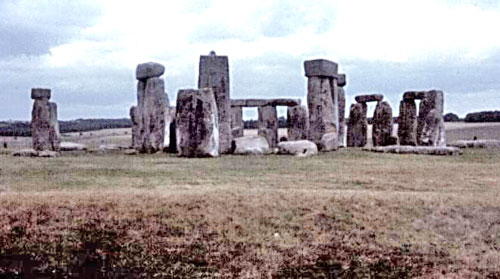
Figure 1. The
"original" Stonehenge on Salisbury Plain, England.
There is, however, some variation in the
path of the moon over the sky, from year to year, so that this first
attempt at a calendar was not very accurate.
Additional stones were
added over the centuries to form complete circles, around a central
altar stone, as the leading shaman or priest-equivalent (this was
long before the Druids) tried to make a more accurate calendar. It
was not, however, until the site was changed from marking the
position of the moon to that of the sun that the "calendar" finally
became accurate enough to pinpoint exact dates.
By this time the importance of the site had been shown by the use of
very large stones to form two of the stone circles. It is these two
circles, the outer sarsen ring, and the inner trilithon ring which
are the features most people consider when they talk of Stonehenge.
The outer of the two rings comprises 30 upright stones which stood
15 ft high was capped by a set of lintels notched to fit on the
uprights and arranged to form a continuous walkway around the top of
the stones.
Within this ring the 5 trilithon (three-stone) ring stands, around
the altar with the highest, or great trilithon, located behind the
altar and standing some 28 ft high.
Less prominent, but more
necessary to tell the time between the major days when the sun shone
in alignment with the great stones, a smaller bluestone ring of
single stones was erected. There were 19 of these and it is likely
no coincidence that 19 multiplied by 19 equals 361 which, if one
adds 4 days for fasting, celebration and recovery to mark the end of
the year, gives us a calendar.
There is a reference in some of the
ancient Gaelic legends to days "when time stands still." (The
Bahai
faith has also, quite independently, developed such a calendar.)
An
alternative explanation has been proposed by Gerald Hawkins, who
suggests that these nineteen stones are related to the 18.61 year
cycle during which the moon-rise position will oscillate along the
local horizon.
This then, very simply, was the basic model from which the UMR-Stonehenge
idea was developed. The word stonehenge itself means "hanging stone"
(for more information see bibliography) from the lintels that cap
the rocks.
Back to Top
Why Build a
Stonehenge Here?
The University of Missouri-Rolla is a leading University in
engineering, computer science and mining technology. When Dr. Joseph Marchello became Chancellor, he came from the University of
Maryland, where he had helped found the Center for Archaeo-Astronomy.
This interest, and the unique combination of expertise at
Rolla,
especially that of Dr Joseph Senne, then Chairman of Civil
Engineering and a local astronomer, and the UMR high pressure
waterjet group, led him to propose construction of the project to
the alumni, who funded it.
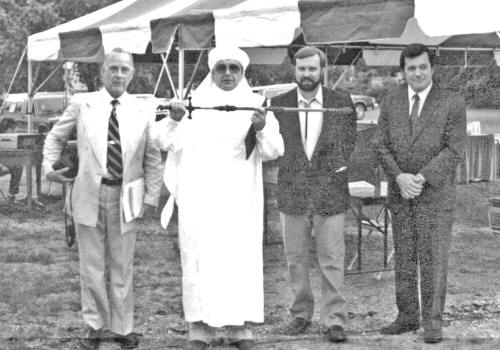
Figure 2. (From the
left) Dr Senne, Mr Bevan, Dr Carlson and Chancellor Marchello.
Back to Top
What is the
Stonehenge built from and where did it come from?
The UMR-Stonehenge is made of
granite which was quarried in Elberton, Georgia. The rock is a hard
igneous stone, which is commonly used for monuments. Elberton,
Georgia is a major center of the American Granite Quarrying
industry.
This happened partially because, in 1978, the National
Science Foundation funded a study to find better ways of quarrying
granite in the United States. One of the ways that were tested was
through the use of high pressure waterjets and Dr. Summers of the
UMR RMERC was one of the panelists who worked on that program.
It is interesting to note that one of the quarries in which the
original testing of waterjetting was carried out in 1978, later
served as the source rock for the granite which forms the UMR
Stonehenge. The work was subcontracted from the Elberton Granite
Association to Georgia Institute of Technology. UMR carried out a
field demonstration for this consortium during the week of November
27, 1978.
Cutting rates of almost 24 sq.ft/hour were achieved in the
overlying "sap" stone, and a slot was cut some 18 ft long and 42
inches deep. In the solid higher quality stone cutting rates were
around 12 - 15 sq.ft/hour.
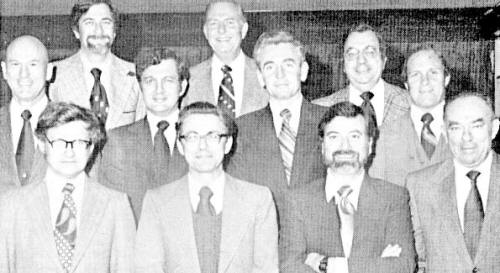
Figure 3. Original
NSF panel:
Dr. Summers (UMR)
Mr. Tessner (Ga Tech)
Mr. Stengel
(Northwest Granite)
Mr. Ralph (Barre,
VT); 2nd row Mr. Tyler (Century Granite)
Dr. Hakala (NSF); Mr.
McGarity (Harmony Blue)
Mr. Harper (Apex
Granite)
3rd row Mr. Wright (Ga
Tech)
Mr. Coggins (Coggins
Granite)
Mr. Kelly (EGA)
Back to Top
Why didn't we
use Missouri granite?
At the time that the monument was being planned the only granite
quarry in Missouri was closed, and we were unable to negotiate to
obtain rock from this site.
Although we received considerable help
from the Missouri Department of Natural Resources, we were unable to
find an alternative site from which we could economically have
obtained the rock.
Back to Top
How was the original
rock cut, and was this done the same way?
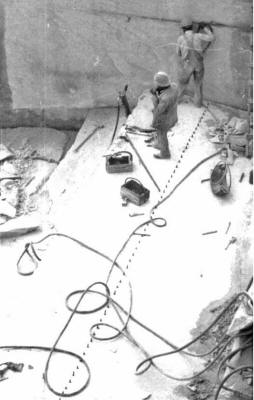
Figure 4. Wedges
driven along the bedding of a block to split it.
The original Stonehenge is made of
varieties of sandstone rock.
This rock has a clear bedding plane to
it, so that it can be relatively easily split to form flat surfaces.
Mining in Britain had been going on for at least a thousand years
before Stonehenge was built, so that skilled miners would know how,
using round stone hammers (still remaining at the site) flint
chisels and deer antlers, to shape the stone.
Final carving to shape
was probably done by manually chipping the rock, after the rocks had
been moved into their final position. We surmise this from the
evidence of tools which were found at the site.
The rock for the UMR-Stonehenge was originally quarried by two
methods, one of which is not that much different from the original.
In this method a set of wedges is placed into a line of holes along
the line of break wanted. The wedges are then hit, in turn, with a
hammer and, in a short time, enough force builds up along the line
that the rock breaks.
When cuts must be made across the bedding, splitting won't work and
the rock was cut out using a flame cutting torch, something which
looks like but is much bigger than a normal oxy-acetylene torch.
These lances are up to 10 ft long, and can cut the granite at about
ten square feet of rock an hour.
They are very noisy and are now
being replaced in quarries by diamond impregnated wire cutting saws.
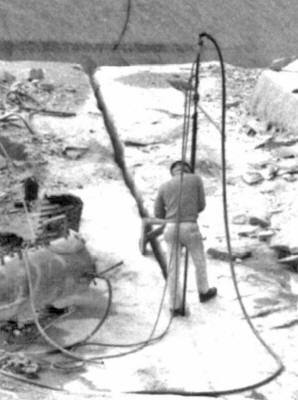
Figure 5. Slot being
cut into the solid rock with a thermal lance.
In modern quarrying the rock is broken
out from the solid in large blocks which are then split into smaller
pieces by line drilling.
At the time that the rock was quarried for
our Stonehenge, however, this practice was not common, and the rock
which we received was not cut into the more regular shapes which are
now produced from most quarries.
In fact, since this brochure was first prepared the technology has
changed again twice. The first change was to the use of diamond wire
sawing. In this method a hole is drilled along the back edges of a
cut and a long wire is threaded through the hole. At intervals
along the wire small beads of plastic are mounted, which contain
diamond particles. The wire is tensioned and formed into a loop,
which is continuously pulled through the cut.
This creates a very narrow cut (which
increases the amount of quality granite produced) and leaves a very
smooth surface which can be used as one of the edges of the stone,
whereas with the earlier methods the edge had later to be removed.
(The latest method will be discussed later).
Those earlier methods
left the rock which we received in Rolla in a ragged shape.
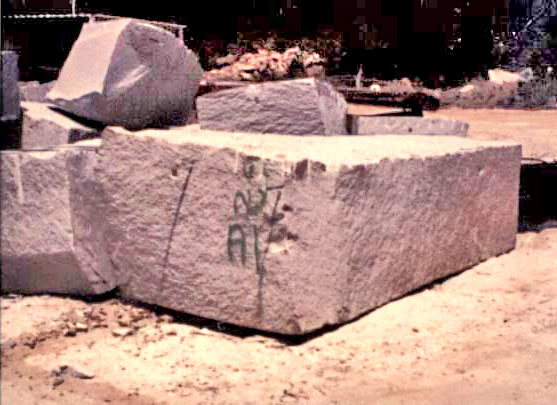
Figure 6. Typical
shape of the rock blocks as received at Rolla.
Once the rock was brought to Rolla a
then novel method of mining, pioneered at UMR, was used to cut the
rock.
Water was pressurized to 15,000 psi (7.5 tons to the square
inch) and forced through a cutting lance fitted with two small
holes, each about 0.04 inches wide (about the size of the wire in a
paperclip).
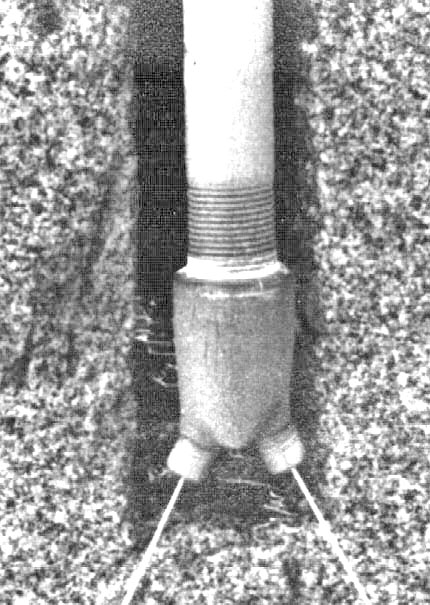
Figure 7. Cutting
nozzle, showing the jets at low pressure.
These jets are spun, at a speed of 180
rpm and the whole cutting assembly moves over the rock at a speed of
10 ft/min.
As the jets hit the rock, they cut a slot between a
quarter and a half inch deep and two inches wide. The cutting lance
is then lowered this amount, and moved back over the slot. A frame
was erected at the Rock Mechanics and Explosives Research Center to
cut the rock.
It was assembled from wooden ties and
radio antenna mast sections and provided a base along which the
cutting lance was moved. A wire mesh screen was fitted around the
frame to protect the operator from the small pieces of flying rock
which were removed by the jets during the cutting process.
The
cutting lance was pulled along the frame using a bicycle chain, and
two small hydraulic motors were used, one to turn the nozzle
assembly, and the other to draw it along the rock surface.
During the course of the rock cutting
the jets were able to cut an average of sixteen square feet of rock
an hour. The generator used to power the entire operation used
between four and six gallons of fuel an hour.
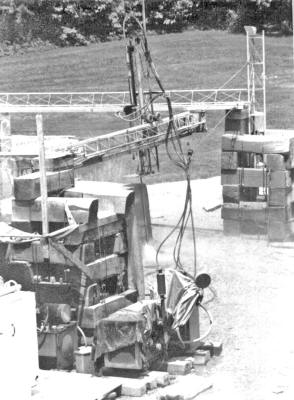
Figure 8. Cutting
Frame used to carve the individual rocks.
In this way a relatively straight cut
can be made on the rock surface without further damage to the rock.
You can see the lines left by individual passes of the jets on some
of the rocks.
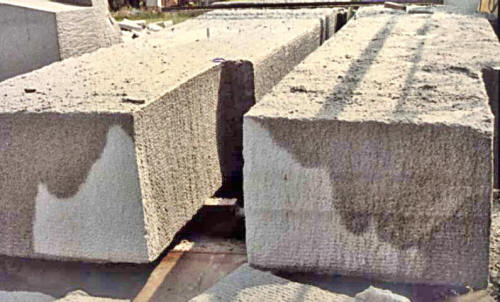
Figure 9. Carved
blocks for the North trilithon legs.
The base of the analemma stone was left
partially uncut so that future generations could see how it was done
(although it is buried under the current ground level). The lower analemma stone sits on a concrete pad and has two slots in its base,
so that it can be re-leveled if necessary.
The organizing committee felt that this
was an important consideration, when it is recognized that Missouri
contains a fault at New Madrid which caused one of the largest
earthquakes in recorded American history.
It will be easier to
re-align the smaller analemma blocks, rather than the trilithons,
after the next such earthquake.
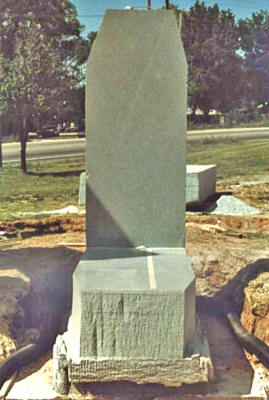
Figure 10. Detail of
the lower analemma stone, before it was covered by soil.
UMR-Stonehenge is the first major
structure to be carved using high pressure waterjets, it marks the
transition from mechanical excavation of rock to hydraulic
excavation and thus is a major mining milestone.
The monument was carved by a group now known as the High Pressure Waterjet Laboratory within the
Rock Mechanics and Explosives
Research Center at UMR. Under the overall direction of Dr. Summers
the day-to-day work was supervised by Dr. Marian Mazurkiewicz and
carried out largely by a group of undergraduate students.
The rock
was moved around during the cutting process using a crane.
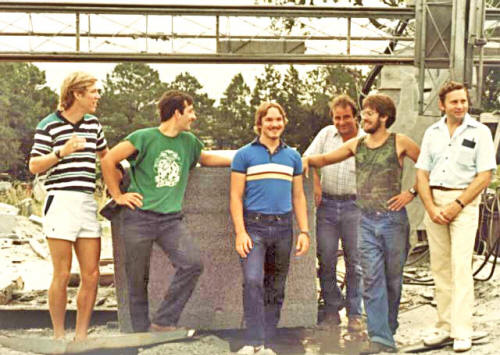
Figure 11. The final
group of students who completed the rock cutting
(Dr. Mazurkiewicz
is at the right and Mr. Gabriele who provided the crane service is
at the back).
Back to Top
How did
the ancients move their rock, and how did they and UMR get the rocks
aligned so accurately?
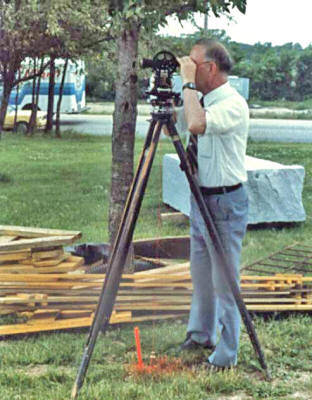
Figure 12. Dr Senne
checking the alignment of the Trilithons.
The rocks for the original Stonehenge
were brought anywhere from 20 to 200 miles to the site.
Contrary to
popular myth, it is unlikely that vast teams of men hauled the rocks
all the way. While it would take some 700 men to pull one rock a
mile a day, oxen of that period could pull between 1,200 and 4,000
lbs each a distance of 20 miles a day, so that a span of 15 to 50
animals could have made the transport much easier and quicker.
The rocks would then be raised up a ramp and lowered into position.
By sharpening the bottom of the stones a little, it was then
possible to "walk" them into their final position. Final carving to
exact shape was completed after the stones had been erected.
For UMR-Stonehenge, the rocks were brought to UMR by truck and rail.
They were carved to shape at the Rock Mechanics and Explosives
Research Center and then brought to the site by truck.
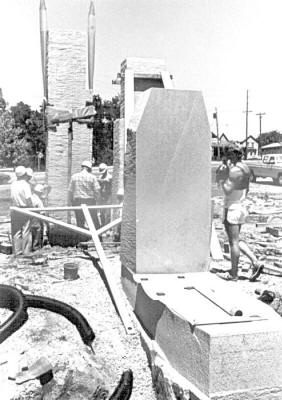
Figure 13. Using a
crane and straps to position one of the Trilithons.
It took over four hours to get each rock
accurately aligned.
The great trilithon ring is set on an 18 in.
thick concrete pad and each rock was set on this. Straps were tied
around the center of each stone to lower them into place, and they
were then held in position using wooden braces until they could be
accurately aligned and set in the concrete.
Wedges were then driven under the
smaller stones (shims had to be set under the larger ones after
lifting it with the crane) until they were level.
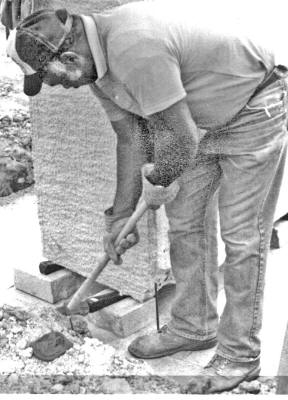
Figure 14. Adjusting
the block alignment with a wedge.
For the analemma stones where accuracy
is critical, the rock angle was first measured, (it was 89.5 deg)
and to ensure accuracy, 3 pins were set between the two rocks, while
a shim 1/16 in. thick was placed under the back of the upright
stone.
The upright was set the first time it
was placed. The gap between the stones was then sealed with resin.
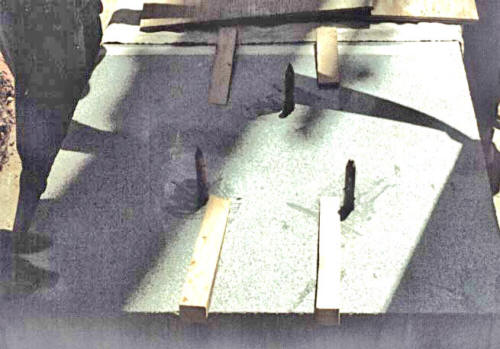
Figure 15. The three
pins used to align the anelemma stones.
Each rock was aligned by Dr. Senne who
used the UMR computer to accurately identify the position of the
stones.
Each stone was set, in turn, on the 18
inch thick concrete slab, which runs underneath the entire assembly
of the five main trilithons.
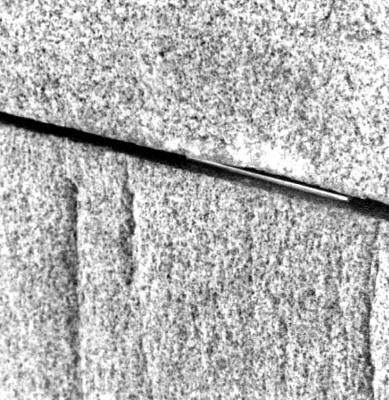
Figure 16. The small
brass wedge used to align the analemma.
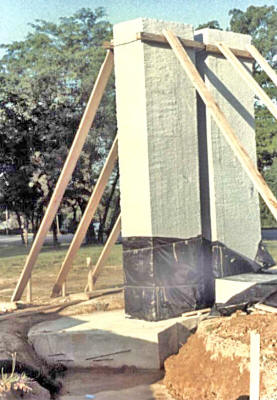
Figure 17. South Trilithon Legs braced in position while the
concrete sets.
Another 18 inches of concrete was then
poured around each stone to hold it in place, and a wooden
scaffolding was used to hold the rock in place until the concrete
set.
Back to Top
|